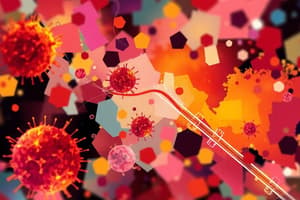Podcast
Questions and Answers
What is the primary purpose of the Enzyme-Linked Immunosorbent Assay (ELISA)?
What is the primary purpose of the Enzyme-Linked Immunosorbent Assay (ELISA)?
- To detect and quantify antigens or antibodies (correct)
- To analyze the characteristics of cells
- To visualize antigens in cells
- To confirm the presence of genetic material
How does Western Blotting work?
How does Western Blotting work?
- By measuring fluorescence emitted from living cells
- By binding antibodies to visible markers
- By separating proteins via electrophoresis, then probing with antibodies (correct)
- By visually detecting agglutination of particles
What type of test uses labeled antibodies and fluorescence microscopy?
What type of test uses labeled antibodies and fluorescence microscopy?
- Flow Cytometry
- Agglutination Tests
- Lateral Flow Assays
- Immunofluorescence (correct)
Which method is primarily used for blood typing?
Which method is primarily used for blood typing?
What is the main application of Flow Cytometry?
What is the main application of Flow Cytometry?
What is the purpose of Lateral Flow Assays?
What is the purpose of Lateral Flow Assays?
Which method is used for confirmatory testing for HIV?
Which method is used for confirmatory testing for HIV?
What process does an agglutination test utilize to identify antigens?
What process does an agglutination test utilize to identify antigens?
Which of the following methods is a rapid point-of-care test?
Which of the following methods is a rapid point-of-care test?
What is one of the main applications of Immunofluorescence?
What is one of the main applications of Immunofluorescence?
Flashcards
ELISA
ELISA
A lab test that uses antibodies or antigens linked to enzymes to detect and measure specific substances in samples. It produces a color change when a substrate is added.
Western Blot
Western Blot
A method that separates proteins by size, transfers them to a membrane, and uses antibodies to detect specific proteins in a sample.
Immunofluorescence
Immunofluorescence
A technique that uses fluorescently labeled antibodies to visualize antigens in tissues or cells.
Agglutination Test
Agglutination Test
Signup and view all the flashcards
Flow Cytometry
Flow Cytometry
Signup and view all the flashcards
Lateral Flow Assays
Lateral Flow Assays
Signup and view all the flashcards
Probing (in Western Blot)
Probing (in Western Blot)
Signup and view all the flashcards
What is the purpose of Immunological methods?
What is the purpose of Immunological methods?
Signup and view all the flashcards
What is the main principle behind immunological methods?
What is the main principle behind immunological methods?
Signup and view all the flashcards
How do ELISA, immunofluorescence, and Western Blot differ?
How do ELISA, immunofluorescence, and Western Blot differ?
Signup and view all the flashcards
Study Notes
Immunological Methods
- These methods use antigen-antibody interactions to identify or measure specific microbes, their parts, or the immune response.
ELISA (Enzyme-Linked Immunosorbent Assay)
- Purpose: Detects and quantifies antigens or antibodies.
- Mechanism: Enzyme-linked antibody or antigen produces a color change with a substrate.
- Applications: Diagnosing infections (HIV, hepatitis), detecting toxins.
Western Blot
- Purpose: Identifies specific proteins (antigens or antibodies).
- Mechanism: Proteins separated by electrophoresis, transferred to a membrane, probed with antibodies. Probing uses a labeled molecule to find a specific sequence.
- Applications: Confirms HIV and Lyme disease diagnoses.
Immunofluorescence
- Purpose: Visualizes antigens in tissues or cells using fluorescent antibodies.
- Mechanism: Antibodies bind to antigens, viewed using fluorescence microscopy.
- Applications: Detects pathogens in samples (Chlamydia, Plasmodium).
Agglutination Tests
- Purpose: Identifies antigens or antibodies by visible clumping.
- Mechanism: Antibodies bind to antigens on particles causing clumping.
- Applications: Blood typing, identifying bacteria or viruses.
Flow Cytometry
- Purpose: Examines physical and chemical features of cells or particles, often using labeled antibodies.
- Mechanism: Cells pass a laser beam, and emitted fluorescence is measured.
- Applications: Analyzing immune systems, identifying specific immune cells.
Lateral Flow Assays (Rapid Tests)
- Purpose: Quickly detects antigens or antibodies (e.g., pregnancy tests, COVID-19 tests).
- Mechanism: Antigen or antibody binds to labeled antibodies as the sample travels a test strip.
- Applications: Point-of-care testing.
Studying That Suits You
Use AI to generate personalized quizzes and flashcards to suit your learning preferences.



